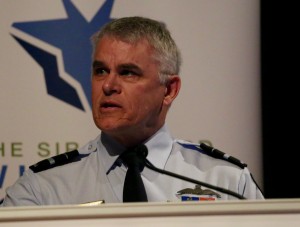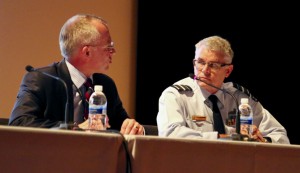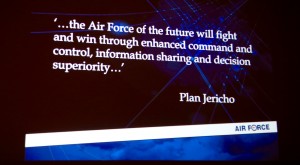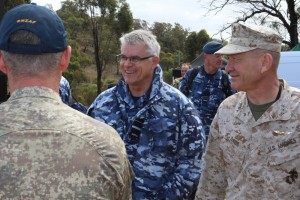2016-04-04 By Robbin Laird
Air Vice-Marshal Gavin Turnbull is the Air Commander Australia. Air Command is the operational arm of the Royal Australian Air Force.
The Commander is responsible for all operational Air Force tasks, and reports to the Chief of Air Force. The Air Commander raises trains and sustains forces for assignment to operations under the Chief of Joint Operations (CJOPS). His position is similar to that of the Commander of the Air Combat Command at Langley AFB.
This means that operations flow into training, and training into operations in a never-ending combat learning cycle.
For the RAAF with its Plan Jericho approach and working to integrate its new platforms into an evolving force, and with the clear desire to be a catalyst and beneficiary of an evolving joint force structure re-design, the Air Commander is focused upon shaping more effective training for the evolving structure of the joint force.
In part, this is why the RAAF has stood up its new Air Warfare Center.
According to Australian Aviation, the stand up of the new Centre can be understood as follows:
The RAAF has formally stood up the Air Warfare Centre, a key element of its Plan Jericho transformation plan, during a ceremony at RAAF Base Edinburgh on February 25.
Air Warfare Centre (AWC) replaces the former Aerospace Operational Support Group (or AOSG) and achieved an initial operational capability (IOC) on January 11.
“The future of the AWC is as dynamic as it is exciting. Importantly, you will have a key role to play in the transformation of the Air Force in the future,” AWC commander Air Commodore Stephen Meredith said at the ceremony.
“The RAAF AWC is a first for Air Force and is an extremely exciting opportunity not only for my staff but for the wider Australian Defence Organisation.”

The old AOSG comprised the Development and Test Wing and the Information Warfare Wing, and also had responsibility for the Woomera test range. In its place the new AWC is structured into directorates, comprising Integrated Mission Support, Capability and Logistics, Test and Evaluation, Information Warfare, Air Force Ranges, and Tactics and Training. Like AOSG, AWC’s headquarters and most of its units are based at RAAF Base Edinburgh.
“By working with the other force element groups, Army, Navy and defence industry, the AWC will allow Air Force to generate rapid, cogent and integrated capability solutions that are needed now and into the future,” Air Commander Australia Air Vice-Marshal Gavin Turnbull said at the opening.
“It will identify innovative solutions and translate those into capability by driving integrated tactics and advanced warfare across Air Command.”
The establishment of an air warfare centre was heralded by then Chief of Air Force Air Marshal Geoff Brown in his launch of Plan Jericho in February 2015.
The subsequent Plan Jericho ‘Program of Work’ document notes that: “Air Force lacks the systemic ability to generate rapid, cogent and integrated combat capability solutions in response to current and future capability gaps and bottom-up innovation opportunities.”
In response it promises that: “an Air Warfare Centre … will become the centre of innovation and thinking for integrated operations.”
Air Warfare Centre’s (AWC) full operational capability (FOC) is scheduled for 2020.
As the RAAF Chief of Staff sees the challenge of integration in 21st century conditions:
“It is like a jig saw puzzle.
You have these really nice pieces to the puzzle sitting in the container, but until you begin to look at the picture your trying to create through the overall puzzle, you do not know which bit goes where.”
For Turnbull, it is clear that the new Air Warfare Centre is a key asset in shaping a way to navigate the waters of the future.
In his presentation at the 2015 Airpower Conference, which dealt with multi-domain integration, Air Vice-Marshal Turnbull highlighted the role he saw for the AWC as a key player in helping the RAAF navigate the future with regard to effective force structure integration.
As he highlighted in his presentation, the required outcomes of the AWC was as follows:
- Testing of current and proposed Concepts of Operation (CONOPS) against force structure and higher level defense planes;
- Collation of lessons learned through experimentation for inclusion in strategic planning, capability development doctrine development and exercise planning; and.
- An optimized structure promoting the exchange of ideas across the
- ADF; interfacing with coalition partners.
Air Vice-Marshal Gavin Turnbull Presentation to Airpower Conference March 2016
The Air Vice-Marshal followed this presentation with one at the Williams Foundation which focused in many ways on the key venue through which much operational integration occurs and will evolve in the years ahead, namely sensor fused network centric warfare by which he meant how do we get the right information to the right people at the right time?

During the airpower conference, I had a chance to sit down and talk with him about his approach. This is the second time I have had the opportunity to talk with him, the first was a phone interview during my last visit to Australia in August 2015.
To be clear about the role of integrated forces seen from his perspective, this response in the last interview provides a clear focal point:
Question: Too often integration means shooting for the lowest common denominator, and combat is not a place where the lowest common denominator is where you want to go.
Assimilation often passes for integration, but obviously you have in mind a much higher target for integration.
How would you characterize your target goal?
Air Vice Marshal Turnbull: Assimilation I think is a word that we don’t need to even have in our vocabulary because it’s implies vanilla and gray.
Lethal is the world we live in and people need to keep their eye on that fact.
We don’t play games and we’re here for a reason.
In the March 2016 interview we discussed the build out from the integrated task force in the Middle East experience and lessons being learned to shape a more effective integrated ADF.
Question: The deployment of your air task force the Middle East was the first time that you deployed a completely integrated Air Force package such a long distance to engage in coalition operations.
How significant has this been in shaping your thinking moving forward?
Answer: Very significant.
It has been a long period of growth where we have added the capabilities to be able to deploy our own forces to an area of interest for the Australian state. Prior to this, we could take key elements of an integrated force package but needed to rely on others, most often on the USAF, to deploy to an area of interest.
It wasn’t good enough that as a sovereign nation in our region, we were reliant on somebody else to actually get off our shores.
But adding our own strategic lift and tanking has created a new situation for us. The deployment to the Middle East has been proof of concept for us with regard to our ability to project power and to provide for our combat support.
The speed with which we deployed and the nature of the capabilities we deployed are a testament to the work we’ve done to learn our lessons from the past two decades into our current environment.
And now we can build upon this deployment which deployed as individual components into a task group to move forward and to learn how to integrate our force package into a true fused capability.
The focus going forward is that each of those platforms are contributing to the greater whole, particularly with regard to the central focus on how to prevail as a connected force.

Question: The deployment of an integrated task force to the Middle East with lift and tanking built in has clearly been a benchmark for you moving forward, but it is also about changing the culture and mindset and innovating towards the kind of joint force which is the core work in progress for 21st century force structure.
What is your sense of the culture change challenge?
Answer: It is central.
We are doing that from the headquarters down through the force elements groups. With the Air Warfare Centre across the top, we are turning our Air Force into one that thinks integration from the start.
We need to understand our sister service capabilities from the start and will use the warfare instructors course and the AWC to integrate that understanding across our future workforce.
Question: When we visited your KC-30A test team at Edwards, one of the key points driven home by the team was how important the built-in situational awareness in the aircraft to reshaping their approach to tanking in the area of interest.
How does this illustrate your evolving approach?
Answer: What we have given the tanker crew is what the fighter pilot experienced in the first decade of the 21st century.
We added Link 16 into the cockpit and suddenly they had situational awareness of the battlespace around them and could now work within the battlespace, rather than simply going to a tanker track and acting as a gas station in the sky waiting for the planes to come in to get gassed up.
This has meant changing the skill set for the tanker crew as well.
We need to have smart people with smart situational awareness combat skills rather than truck drivers. They now position themselves where they’re next needed.
They’re maintaining their awareness and they’re moving into the battle space, and the jets are coming off their targets and are surprised about how close the tanker is.
In fact, we’re starting to get the reverse complaint where pilots who are coming off targets don’t have time to think and reconfigure their airplane before they’re on the wing of the tanker getting some more fuel.
Question: You are undergoing the culture change for a more integrated force BEFORE you get what is called a joint strike fighter.
How does that preparation affect how the RAAF can introduce what the plane can do for the entire ADF, and not just for traditional air combat?
Answer: We are reshaping our expeditionary air force capabilities, building new infrastructure, and rethinking how to better mesh decision making at the point of attack with the enhanced situational awareness which allows those at the point of attack to make good decisions.
The F-35 clearly is about decision-making and ISR but we are not waiting for the plane to show up before we reshape our ability to use fused data and to push information to the right people at the right time in order to make the right decisions.
I’m thinking about decision making in the cockpit back to the strategic level, but teaching the JSF pilot how to operate in the decision space where he can be a decision-maker, that’s what we need to do as well to shape an ability to get better decisions at the point of attack or defense.

And we are focused throughout the force on how to work the shift forward to the operational level most capable of achieving the desired effect.
We have already purchased secure mobile facilities. We are growing our security forces over the next four to five years up to the required numbers. We have additional personnel that the government is allowing us to have as the JSF capability comes in.
Our combat support group is very highly focused on being expeditionary, containerized, and mobile with regards to standing up expeditionary bases.
And we are working the integration of the IT systems to allow the deployed forces to know exactly what is where and what the base capabilities are and to fuse that into our own space operation center as well.
Question: With regard to Australia in your region, you have acquired or are acquiring a number of pieces of equipment, which your neighbors are buying as well, such as KC-30A tankers, F-35s and P-8s.
How does common acquisition affect your partnerships in the region as well?
Answer: This is a work in progress but flying similar platforms does open the opportunities for more joint work as well, and we have seen this already with regard to KC-30A and P-8.
Once we start operating all of the new capabilities in the region, we will start to see a lot more collaboration.
This falls into what I call the 80/20 split; you buy a good asset that can give you 80% of what you want; what you can do working with allies and partners is share the experience and the cost to get that additional 20% of capability in collaborative framework.
Appendix: The RAAF Air Warfare Centre
The Air Warfare Centre exists within Air Command and is critical to establishing the RAAF as a modern and fully integrated combat force that can deliver air and space power effects in the information age. The AWC is supported by an integrated workforce which includes Air Force, Army, Navy, Public Service and Defence Industry personnel.
The vision of AWC is: “Excellence in Integrated Air Warfare for optimal Joint Effects”.
Its mission is to: “Deliver Integrated Air Warfighting solutions for superior combat effectiveness”.
The goals of the AWC are to provide:
- A focal point for bottom up innovation at the tactical and operational levels
- Coordinated and integrated tactics and procedures development across all AF platforms using live, virtual and/or constructed (LVC) environments
- Coordination of Science and Technology (S&T) and Research and Development (R&D) effort across AF
- Testing of current and proposed Concepts of Operation (CONOPS) against force structure and higher level Defence plans at the operational and tactical level
- Collation of lessons learned through experimentation for inclusion in strategic planning, capability development, doctrine development, and exercise planning
- Exchange of ideas across the ADF and the Coalition.
The AWC is comprised of the following:
- HQ AWC – responsible for the coordination and implementation of common and integrated functions across the AWC IOT meet the AWC Mission
- Test and Evalution Directorate – the ADF service provider to AF and Army for specialised flight T&E, aviation medicine support, aeronautical information products, stores clearance and aviation systems engineering support
- Information Warfare Directorate – centralises the AF’s tactical information warfare elements and provides the wider RAAF with an integrated and tailorable operational support capability drawn from across the Intelligence, Electronic
- Warfare and Information Operations domains. It enables the coherent development and management of the RAAF’s Information Warfare capabilities
- AF Ranges Directorate – I the primary provider of Air Force Air Weapon Ranges and Live, Virtual and Constructive (LVC) simulation to enable the testing of war materiel and the training of AF capabilities in order to deliver more effective warfighters
- Tactics and Training Directorate – focuses on the development of multi-discipline high end integrated tactics and training across the AF through a combination of training, education engagement and integrated exercises.


